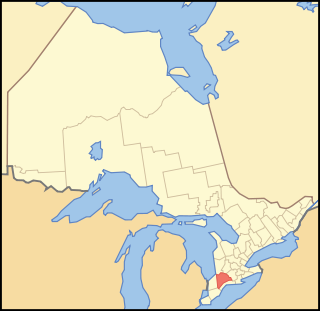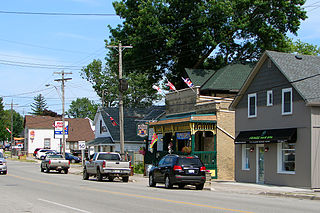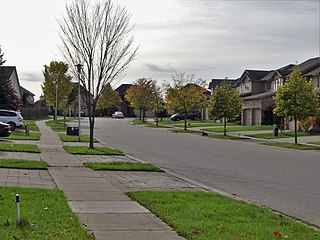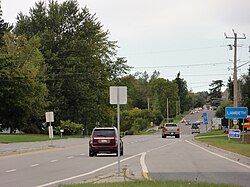
London is a city in southwestern Ontario, Canada, along the Quebec City–Windsor Corridor. The city had a population of 422,324 according to the 2021 Canadian census. London is at the confluence of the Thames River and North Thames River, approximately 200 km (120 mi) from both Toronto and Detroit; and about 230 km (140 mi) from Buffalo, New York. The city of London is politically separate from Middlesex County, though it remains the county seat.

Lambeth is a London borough in South London, England, which forms part of Inner London. Its name was recorded in 1062 as Lambehitha and in 1255 as Lambeth. The geographical centre of London is at Frazier Street near Lambeth North tube station, though nearby Charing Cross on the other side of the Thames in the City of Westminster is traditionally considered the centre of London.

Middlesex County is a primarily rural county in Southwestern Ontario, Canada. Landlocked, the county is bordered by Huron and Perth counties on the north, Oxford County on the east, Elgin County on the south, and Chatham-Kent and Lambton County on the west.

St. Thomas is a city in southwestern Ontario, Canada. It gained its city charter on March 4, 1881. The city is also the seat for Elgin County, although it is independent of the county.

Area codes 416, 647, and 437 are telephone area codes in the North American Numbering Plan (NANP) for the city of Toronto, Ontario, Canada. Area code 416 is one of the original North American area codes created by the American Telephone and Telegraph Company (AT&T) in 1947. Area codes 647 and 437 are additional area codes for the same numbering plan area (NPA), forming an overlay numbering plan.

Middlesex Centre is a township in Middlesex County, in southwestern Ontario, Canada, north and west of London. The Corporation of the Township of Middlesex Centre formed on January 1, 1998, with the amalgamation of the former Townships of Delaware, Lobo, and London. It is part of the London census metropolitan area.

Byron is a neighbourhood in the City of London, Ontario, Canada. It is adjacent to the Thames River in the south-west of London. Almost all of its residents live in low-density, single detached dwellings. As of 2011, the area is home to 15,525 residents. The neighbourhood is considered a high-income area, with an average family income of $130,587 an average dwelling value of $312,896 and a home ownership rate of 93%.
Highbury Avenue is an arterial road located in the Canadian province of Ontario. In addition to serving as a primary north–south thoroughfare in eastern London – through which part of it is a limited-access freeway – the road also provides access to Highway 401 and continues south to St. Thomas. The southern terminus of Highbury Avenue is an intersection with South Edgeware Road, just north of Highway 3 and the eastern end of the St. Thomas Expressway. From there, it travels 45.6 kilometres (28.3 mi) north to Highway 7, east of Elginfield. Outside of London and St. Thomas, the road also passes through the communities of Ballymote and Bryanston. It is designated as Elgin County Road 30 within Central Elgin, and as Middlesex County Road 23 within Middlesex Centre, the two rural municipalities through which the route passes.
Westminster refers to both a neighbourhood in the City of London, Ontario, Canada, and a much larger area within which the neighbourhood lands have been situated.
The Thames Valley District School Board is a public school board in southwestern Ontario, Canada. It was created on January 1, 1998, by the amalgamation of the Elgin County Board of Education, The Board of Education for the City of London, Middlesex County Board of Education, and Oxford County Board of Education.

Dorchester is a town in Ontario whose name first applied to the township and honours Sir Guy Carleton, Lord Dorchester (1724-1808). The name was changed from Dorchester Station on May 3, 1961. Dorchester is the residential and commercial core of the municipality of Thames Centre, in Southwestern Ontario, Canada, a few kilometres directly east of the city of London, Ontario. According to the 2016 census, the town has a population of 3,911.

West Elgin is a municipality in Elgin County, Ontario, Canada. The township was created on January 1, 1998, through the amalgamation of the former township of Aldborough with the village of West Lorne.

Wonderland Road is a major north-south arterial road in London, Ontario, designated as Ontario Highway 4 between Highway 401 and Sunningdale Road. Outside of the City limits, the road extends north into Middlesex Centre as Middlesex County Road 56 and south into Southwold. It is one of the busiest roads in London, carrying over 43,000 vehicles per day between Springbank Drive and Riverside Drive as of 2013.

Uplands is a neighbourhood in the City of London, Ontario, Canada. The neighbourhood is located in the northern part of the city. Almost all of its residents live in low-density, single detached dwellings. As of 2011, the area is home to 7,835 residents. The neighbourhood is considered a middle to upper-income area, with an average family income of $128,806 an average dwelling value of $371,210 and a home ownership rate of 85%.

Fanshawe Pioneer Village is an open-air museum established in 1959 and located in the Fanshawe Conservation Area in London, Ontario. The village uses historical re-enactments to communicate the history of rural communities in the former townships of Westminster, London, North Dorchester, Delaware, West Nissouri and Lobo in Middlesex County from 1820 to 1920 and the founding and development of the City of London up to 1840.
Huron Heights is a neighbourhood in the City of London, Ontario, Canada. Located in the northeast part of the city, development began around 1960 and continued to the late 1960s in four distinct phases, and included three public elementary schools, and provided students to one Catholic elementary in the area and one public secondary school just northwest of the development. A large commercial plaza with anchor grocery and department stores was developed at the west edge, and a neighbourhood plaza was developed in the central part. A city arena was built and later supplemented with a public swimming pool.
Middlesex was a provincial riding in Ontario, Canada, that was created for the 1975 election. It was abolished prior to the 1999 election. It was redistributed into the ridings of Elgin—Middlesex—London, Lambton—Kent—Middlesex, London—Fanshawe, London North Centre, London West and Perth—Middlesex.













